#non-aranara related
Explore tagged Tumblr posts
Text
[4.1] What is "It"?: Theories on Will, Wishes, and Fate
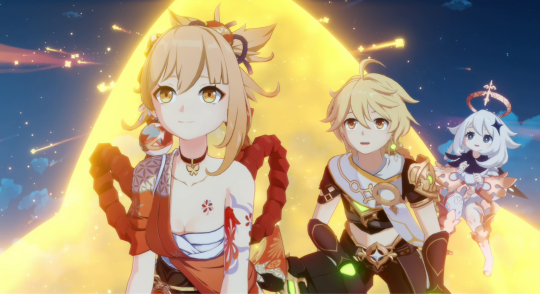
With the finale of Fontaine’s Archon Quest in just a few days, I know there’s a lot of questions I’m personally anticipating the answers to: what is the true origin of the prophecy? What is the Primordial Sea, really? What is the connection between it and the Abyssal whale? And just what exactly did Skirk mean when she said that Childe had awakened “it” and had traces of “it” on him?
Most community theories suggest that “it” just refers to the whale, but like, what is the whale? Why did Childe even see it in the Abyss all those years ago, and why has it reappeared now? Well, I have a few ideas I’d like to explore about that, albeit in a very roundabout way, and they start with a quest that I feel has been severely under-discussed and under-theorized since its release: Yoimiya’s second story quest.
It’s understandable that this quest didn’t get too much buzz between its very unfortunate timing in patch 3.7, when community burnout was exceptionally high, and Honkai Star Rail’s debut as the Shiny New Thing. But it’s also a shame, because this story quest is full of interesting lore, Freudian references, and a few intriguing world building mysteries beneath its very wholesome story and further exploration of Yoimiya’s character. That is to say, the content of Yoimiya’s second story quest really matters. It’s not just because it is the first non-Archon character’s second story quest to date — it’s because it is an incredibly important piece of the puzzle comprised of Nahida’s second story quest, Caribert, and Khvarena of Good and Evil that was preparing us for Fontaine’s plot.
This is an attempt to identify and analyze the connections between Yoimiya’s second story quest and those above, as well as to theorize about the greatest mystery in Yoimiya’s quest, the “Urstone,” and finally tie all of that into Fontaine’s Archon Quest thus far. As that is an ambitious project, this will be far from an exhaustive theory, but I hope to at least get closer to understanding the meaning behind Childe awakening ”it.”
SPOILERS: Fontaine AQ Acts I-IV, Yoimiya’s SQ Act II: Star-Pickers’ Passage, Aranyaka, Nahida’s SQ Act II: Homecoming, Khvarena of Good and Evil, Ei’s SQ Act II: Transient Dreams, Kazuha’s SQ: A Long and Friendless Road (very minor), and Caribert.
A “Story”
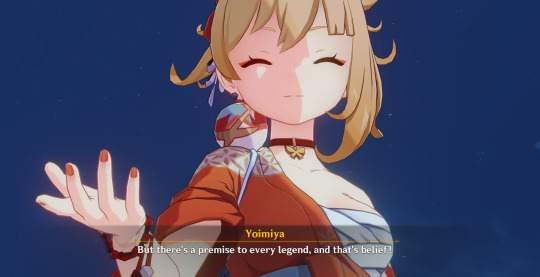
Yoimiya: But there’s a premise to every legend, and that’s belief!
Since it's been a while, let’s start with some recap of Yoimiya’s Act II: Star-Pickers’ Passage.
By chance, the Traveler comes across Yoimiya in Inazuma as she prepares to search for a great meteor shower like the one that her ancestor saw many years ago. It’s patch 3.7, so the Traveler’s got a lot of time to kill and offers to go with her from Ritou to Port Ormos. There, they come across Acara Crafts’ stall that sells Aranara carved figures, which Yoimiya buys out to bring back as souvenirs to Hanamizaka.
In Sumeru City, Yoimiya and the Traveler briefly split up to look for meteor shower leads, and the Traveler runs into Nahida at the Akademiya. Upon learning their journey’s purpose, Nahida explains that meteor showers are unpredictable occurrences related to “intricate fates” interfering with one another, and for this reason seeking one out reliably is impossible.
The Traveler and Paimon are reluctant to tell Yoimiya this out of fear of disappointing her and rendering her journey meaningless, so with Nahida’s help they decide to facilitate the meteor shower through a dream in order to fulfill her wish.
This is the first of many references to psychoanalysis and Sigmund Freud’s theory of dream interpretation in this quest. Freud thought that the psychological purpose of dreams is to fulfill wishes, particularly wishes that we’ve forgotten through repression. He believed that these unfulfilled wishes are what produce the dream itself; the wish “wants” to be remembered, and the mental processes that repress it are weakest at night, so dreams are our mind’s attempt to translate the underlying “thought” that represents the wish into “images” while we sleep. Through dreams, unfulfilled wishes can be made conscious or remembered and fulfilled through a fantasy.
To lure Yoimiya into the dream and sell her their “story”, the Traveler and Paimon craft the perfect pretext so that she fully believes that they are preparing to see a meteor shower. Their pretext’s foundation, namely the idea that meteor showers are summoned by people’s wishes, subtly twists the truth in Nahida’s words so that something intangible and uncontrollable is framed as something with an amount of certainty. In other words, by controlling the pretext, the Traveler and Paimon are able to control “truth.”
Upon reuniting with Yoimiya, the Traveler finds her with a little girl in a wheelchair named Avin. Before parting ways, Yoimiya gives her a carved Aranara souvenir to thank her for guiding her through Sumeru City, and to cheer her up. Yoimiya then tells the Traveler that Avin has an unknown chronic illness that immobilizes her legs, and that she had approached Avin because she seemed to be alone and in a bad mood.
As they refocus on finding the meteor shower, the Traveler and Paimon begin to tell Yoimiya their lie and set the plan in motion. They play the role of magicians using careful misdirection to craft a wonderful illusion; beneath the ruse of finding the right “location” (or “space”) and forging a special device (which can be anything) to observe the meteor shower, they will take Yoimiya on a journey through Sumeru and make memories with her, adding meaning to what is ultimately a trick. With these seeds planted, they head off to Devantaka Mountain to “practice” wishing for the meteor shower.
At the top of the Ruin Golem there, Yoimiya shares more about her motivations for setting out on this journey. As someone who was entrusted with the wishes of everyone in Inazuma who heard of her dream, Yoimiya began to wonder why people derive this meaning from meteor showers in the first place:
Yoimiya: People use fireworks to remember their most precious memories, and these memories sparkle and shine each time the fireworks fly.
Yoimiya: In other words, fireworks symbolize the past. Yoimiya: And shooting stars make people think of wishes because wishes carry people's brilliant hopes and expectations for the future. Yoimiya: One represents the past, and the other the future. They both bloom in the sky, but have completely different meanings behind them.
Yoimiya’s belief that wishes are beautiful things that join the past and the future is what gives her journey meaning, and this is what keeps her moving forward despite the lack of certainty that she will ever find this beauty herself. This admiration for the hope in people’s hearts is what shapes her wish, too.
After returning to Sumeru City, they ask Ahangar for guidance on how to forge an observation device with the purest ore. After some initial skepticism, he chooses to entertain their “story” and tells them about his own profession’s local legend: somewhere, there exists an excellent forging material that few have ever found, and the few who already have it have never used:
Yoimiya: So you mean that [the forging material] symbolizes dreams? Ahangar: Dreams, inspiration, obsession, focus…. Call it what you want. But if you take it to symbolize “purity,” then I believe it is your goal as well. Ahangar: We call it Urstone, but in truth, neither I nor my colleagues have ever seen it.
As they are about to set off and find this Urstone, Avin’s parents show up looking for her after she didn’t return home that day. The Traveler and Yoimiya then find Avin collapsed on the outskirts of Sumeru City. After calming her down, Avin discloses that her illness has not just immobilized her – she has also forgotten her happy memories and how it felt to be passionate before she got sick. With no end in sight to her illness, Avin’s dreams of becoming an adventurer have ended and her world feels as if it is closing in on her – as she later reflects, her world had “shrunk down to a tiny space.” Avin’s illness is an objective truth with material consequences on her life, and this truth ended the fantasy of her innocence, along with her dream of becoming an adventurer one day. This loss of innocence, and therefore loss of childhood, triggered feelings of depression and hopelessness in her. However, the Aranara carving that Yoimiya gave Avin reminded her of her childhood friend, Arashani, who she desperately wanted to see again.
To help Arashani and Avin reunite, the Traveler calls on the Aranara for help with a whistle that Nahida gave them for the dream-meteor shower. When Arapurva arrives, Yoimiya asserts herself as someone who both values childhood innocence and sees children’s dreams as worthy of protection, which earns the Aranara’s trust:
Arapurva: It seems that Red Nara has not yet grown up. Paimon: Huh? What do you mean by that? Arapurva: Time is very important to Nara. Nara walk with time. They remember much, and they forget much. But Red Nara is different. You know how young Nara think. The warmth in your heart is very pure, and it is fierce like the sun.
Arapurva then takes them all to Mawtiyima to find Arashani, and here they enter a collective dream. Before leaving them, Arapurva urges Avin to remember, and that to do so she needs both memories and dreams. Arapurva also says something very interesting, also worth keeping in the back of your head: “Dreams are connected to your heart, not your body.”
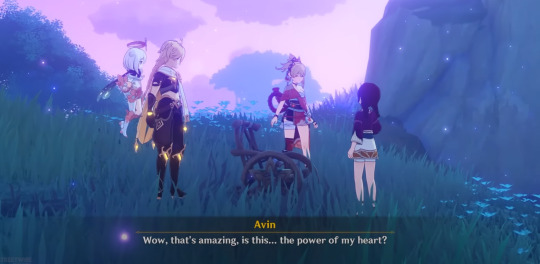
Avin: Wow, that’s amazing, is this…the power of my heart? Video Still from Streetwise Rhapsody
The dream space allows Avin to unite thoughts with belief to create images. Remember, according to Freud, the psychological purpose of dreams is to make conscious an unfulfilled wish – so, in this liminal space between the conscious and unconscious, Avin can create the image of herself walking again just by thinking of it, because it is her wish, and thereby remember how she once felt before she got sick.
As they search for Avin’s memories of Arashani, Yoimiya and Avin chase a wayward “star” across Mawtiyima’s mushroom canopy until they reach an iridescent pale blue stone with a solid partial casing surrounding it. Inside, the stone glitters with the light of the universe.
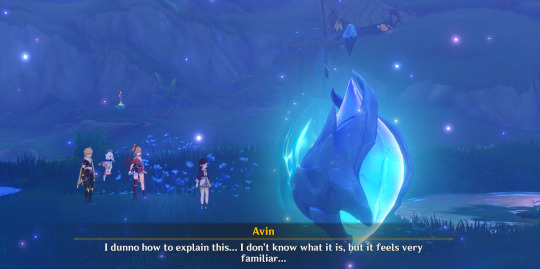
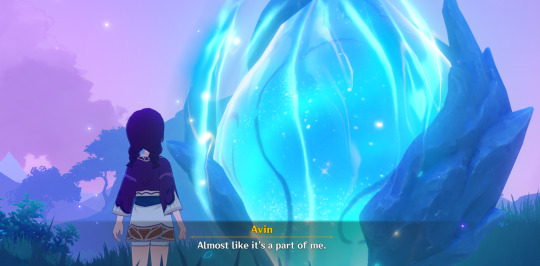
Avin: I dunno how to explain this…I don’t know what it is, but it feels very familiar…Almost like it’s a part of me.
Yoimiya speculates that this stone is what Avin has been searching for all this time, and that it is her Urstone:
Yoimiya: It's a very rare ore that symbolizes a person's aspirations and dreams. Yoimiya: Since you can see it, that means you've found what you've lost. Avin: Is that how it works...? Avin: It's just like in fairy tales... I thought I'd stopped believing in those. Avin: But I'm glad that I found that belief again.
Avin then reaches into the Urstone and passes through it into a deeper layer of the dream, and there she reunites with Arashani, signaling that she has regained her memories. Having found him again, Avin’s hope is renewed and it changes her reality – indeed, it changes her fate. To be clear, Avin can’t dream or wish away her illness in real life, but her hope is what allows her to expand the “tiny space” her world had become in her depression.
After this, the crew seemingly returns to reality, but finds that Arashani is still there along with Arapurva. Having settled her worries, Avin resolves to help Yoimiya and the Traveler achieve their wish to see the meteor shower, and offers them her Urstone…
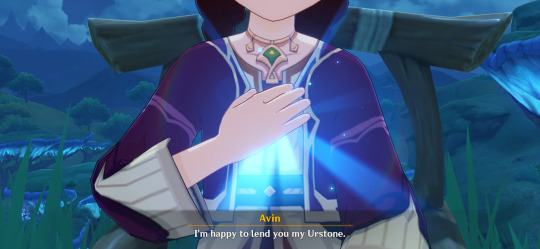
Avin: Yoimiya, you need this Urstone because you want to see a meteor shower? Yoimiya: Yep. Oh! Once we find it, you should come with us! Avin: If that’s how things are…I’m happy to lend you my Urstone.
…And then, Avin pulls a light blue lens from her chest, right over her heart. With this lens crafted using the purest ore, they locate a meteor shower of stars flying up from the ground and ride them through the clouds. Finally, they wake up from the collective dream and part ways in Port Ormos.
The Purest Ore and the Will to Power

Now, there’s a lot to discuss about Yoimiya’s second story quest, and we will get to as much of it as possible, but the bulk of this theory will be focused on trying to understand the Urstone, so that is where we will begin.
Let’s start with what we know from the quest. We are told three things about the Urstone: it is “the purest ore,” it symbolizes dreams, and through the dream we are implicitly told that it represents the power of the heart.
This last area is where we’ll turn the majority of our attention, because from there we can reach a greater understanding of many worldbuilding concepts we’ve encountered in the story thus far. However, all of these definitions of the Urstone work hand-in-hand and do not contradict one another, so they are all helpful to keep in mind going forward.
But what do I mean by “power of the heart?” Well, first let’s harken back to the Aranara quest, Aranyaka, where we learned about the “Sourcesong” and the songs that split off from it through time. By learning all of the songs that represent these branches from the origin, the Aranara get closer to learning the Sourcesong:
Arasudraka: Songs are like rivers. They derive from the same origin, the "Sourcesong." She is the home to all songs and the source of all great rivers. Arasudraka: Then, it changes when it is sung for different memories and different stories, just like how a great river diverges into creeks. Arasudraka: Just like all the creeks eventually flow into the sea, all the songs eventually converge into one, into the Sourcesong. Arasudraka: So Aranara song gatherers have to find all the songs. That way, we can find the Sourcesong.
These songs serve as a metaphor for another theme of Aranyaka, which is the concept of “returning to Sarva,” or returning to Irminsul after death in the form of memories/energy in the Ley Lines. It could also be extended to what we currently understand about the Primordial Sea as the origin of all life, its “source,” and all the lifeforms that arise from it are like the creeks that diverge from the river before they eventually converge back into the sea:
Paimon: What? You mean you don't believe in the prophecy? Augereau: No, no, I believe in the prophecy, but I also believe in another story. Augereau: The story says that people once lived in the ocean. They were one with the ocean and couldn't live apart from it. Augereau: But as time wore on, people desired to live on land and developed blood vessels, encapsulating the sea within their bodies. Thus could people set foot on land. Augereau: So if you ask me, when the water rises and takes us all, it'll be like we're going home.
The philosopher Friedrich Nietzsche was also interested in the idea of things differentiating themselves from a primordial source of sorts, and he uses this language in one of his many attempts to define his most well-known philosophical doctrines, the Will to Power. In Beyond Good and Evil, Nietzsche marks the inner “world of desires and impulses” as the source of emotions (Nietzsche, 35). He likens it to a primitive world where desires exist in a state of unity that then branch off into distinct organic processes. Nietzsche argues that this differentiation arises due to “will,” and that will is the “causality of all things,” and that all will is Will to Power – in other words, the will to dominate and to multiply (Nietzsche 13 & 35).
“Will” is the force that differentiates the primordial soup of our base desires and impulses into distinct organic processes, and these processes then give rise to distinct life forms that separate themselves from the original state of unity. That is, without “will,” we would all still be floating in the unified state of the primordial soup - will is both the cause, and the reason for individuality:
Mary-Ann: Water can take any shape, and life can choose what form it must take. This, however, has nothing to do with its essence. That is a different matter.
If you’ve been following the Narzissenkreuz Institute world quest plot, this discussion of “will'' should be ringing some bells. In Khvarena of Good and Evil, we came across Rene’s Investigation Notes in the Girdle of Sands, which talked about the power of Khvarena and a blurred out word (likely “Abyss'' or “Void”) containing a will of their own that can recognize itself, unlike the power of the Elements:
...Though the results are nothing impressive, this is because the object [the Khaenri’ahns] chose was pure elemental force, which lacks any will whatsoever. Like the difference between the Director and a Hydro Slime, perhaps? […] Even though the calculated result is unchanged, but if the refinement method is reflected... If the power of... then maybe we can extract the "will" within. Using this method... resist the impact…
The investigation notes do two things here that we’re interested in: first, they establish the presence of “will” as the distinction between elemental energy, such as that found in Azosite, and the higher powers represented by Khvarena and “Void,” and second, they raise the possibility that “will” is something that can be removed from its vessel, so to speak, or perhaps manipulated. Just keep this in the back of your mind for now, too, we’ll come back to it much later.
If we apply this concept of will back to the Sourcesong story, then it is will that differentiates each song into its own unique form, but each song still contains the essence of the Sourcesong from which it arose. A similar story is told about the five branches of the Raiden Gokaden. In Kazuha’s Story Quest, Amenoma Tougo likens the Raiden Gokaden to schools of thought that originate from a single source, with each branch carrying its own philosophy. Kazuha’s family’s school, the Isshin Art, seeks “complete harmony between blade and mind” during the forging process, because they believed this was the only way for a blade to “capture and convey its maker's thoughts and feelings, and eventually become an extension of its wielder's will.”
This is a very important concept as we move forward. If we think of will as what differentiates each forging art of the Raiden Gokaden from each other and their source, and each branch is considered a unique school of thought and philosophy of blade forging, then thoughts are an essential component of will. If a blade that these philosophies produce is meant to capture the thoughts and feelings of its respective forging branch, such that they are an extension of will, then will can be further defined as the cause and reason that an abstract form (thoughts and feelings) is translated into a physical form (an object, such as a blade). It is both the how and the why.
Put another way, the blade is the bladesmith’s will embodied. It is the bladesmith’s thoughts and feelings, which we have just established are an essential component of will, given a physical form. The thoughts and feelings are will, the object is will, and the “force” that translates the abstract into the physical is will. So basically, it’s all will, but in different forms.
But so what? Well, let’s go back to the amazing feat that Avin accomplished towards the end of the story quest. She asks Yoimiya what she needs, then says she will lend her Urstone to Yoimiya to help her achieve her dreams, and what does she then do? She pulls a viewing lens from her chest, right over her heart.
That is what the Urstone is. The Urstone is the source of a person’s will, and the Urstone is associated with the power of the heart, which would also make “will” the power of the heart. Will is what underlies the power of creation and imagination, or as Ashikai puts it in her theory of Irminsul’s true purpose, the power by which “thoughts become things.”
The purest ore was needed to craft the observation device, and of course the purest ore would come from the purest will – a child’s will. What’s more, Yoimiya and the Traveler never even mentioned what kind of device they needed to forge with the Urstone. It was Avin’s will to help her friends that materialized their thoughts into an object. The implications of this are fascinating, though this theory isn’t going to go there. Instead, I’d recommend watching Ashikai’s video above if you’re interested in that train of thought.
The Seed of Ideas*
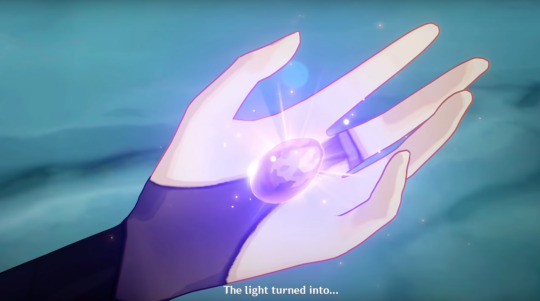
Paimon: The light turned into…a seed?
Having established this connection between thoughts/feelings, the power of the heart, and “will,” let’s see how else we can think about the Urstone. I noticed that “will” turns up in a couple of other recent to semi-recent contexts, and both of them involve the origin of some important trees in the open world.
To start, let’s revisit Ei’s second story quest. As a lightning fast refresher, Ei and the Traveler were investigating Rifthound activity near the roots of the Sacred Sakura tree, which we know protects Inazuma by purifying “filth” from the earth, or rather the memories of people who died on the land. This is meant to mirror Irminsul, since the Ley Lines also contain memories and are Irminsul’s root system. With the Sacred Sakura’s roots damaged, this “filth” leaks out, and the memories within are briefly re-projected onto the land.
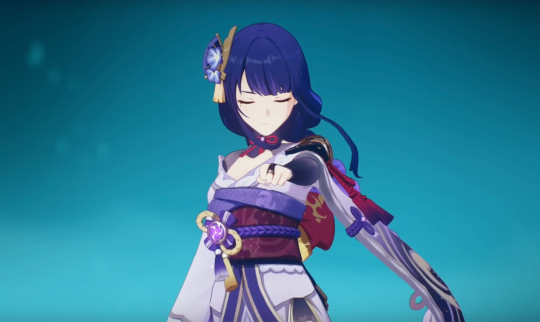
As Ei confronts her past through these memories of Inazuma, she vocalizes her change of heart since the Vision Hunt Decree and her newfound will. The Shogun then challenges her to a duel in Raiden Makoto’s realm of consciousness, which Ei preserved before she passed away 500 years ago. When Ei successfully proves the strength of her will to the Shogun, she awakens another fragment of Makoto that she hid inside Musou Isshin. Interestingly, Makoto calls this a fragment of her will. Upon awakening her will, it becomes a seed that Ei plants in the realm of consciousness, which grows the Sacred Sakura tree in the real world. In other words, the Sacred Sakura tree is Makoto’s will given a physical form, another example of someone’s will embodied.
But this is not even the first time that will has been represented to players as a seed. In Dragonspine, the Frostbearing Tree goes through a physical transformation as the Traveler offers it more and more Crimson Agate, which is a crystal tainted with Durin’s abyssal blood. After offering enough Crimson Agate, we get the blueprint for the Frostbearer catalyst, which tells us an interesting story:
A long, long time later, yet still long ago — When the deathmatch between the dragons of darkness and wind was decided at last, When corrosive blood stained the ashen valley red, The tree, at last, remembered that it had not died with that entombed city, And it extended its greedy roots towards the warm ichor that irrigated the land. Because a certain someone poured out a crimson essence upon it, The tree that should have long died remembered its past, And bore a single fruit from the coalescence of all its might…
As creepy as the Frostbearer catalyst lore is, there’s another useful analogy to be made here so that we can better understand Avin and her Urstone.
Think of Avin as the Frostbearing Tree, a tree that “should have died” but remembered its past upon being offered Durin’s blood. This may seem like a strange comparison at first, but Durin’s blood is conceptually not so different from the memories flowing in the Ley Lines like water, or the filth flowing through the roots of the Sacred Sakura tree, just as Durin’s “heart” is likely a similar anchor for his consciousness as Elynas’s is, just as Makoto’s fragment of her will became the seed or “source” of the Sacred Sakura, or the “Urstone,” we theorize, is the source of an individual’s will.
Basically, Durin’s blood is a liquid form of his will that can change the “shape'' of the objects it comes into contact with, and upon being exposed to it the Frostbearing Tree remembers what its life was like before the Skyfrost Nail dropped on Sal Vindagnyr. This is very similar to how Avin remembered her happiness before her illness through the magic of the dream space and finding her Urstone. And upon remembering its past, the Frostbearing Tree bears the “fruit” that is the Frostbearer catalyst, the “coalescence of all its might,” but Avin bore the observation lens. Both are products of their source’s will, but have different emotions behind them due to their difference in purity.
But there’s one last thing I want to point out about the Frostbearer catalyst before moving on to the next point. A fruit is like a sugary case for a plant’s seeds, so what might this structure be in the center of the Frostbearer catalyst?
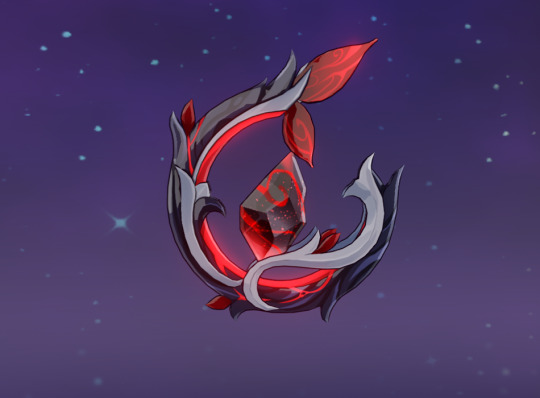
That’s right. A “seed,” which also resembles a gem or a stone. And not too unlike the general shape of the Urstone, I would add.
But you know what else the Frostbearer catalyst and the Urstone really remind me of? The Fire Seed from Nahida’s second story quest. Although the Fire Seed neither becomes a tree nor seems to come from one (though this is also debatable if you consider Rukkhadevata and Nahida to be like…smaller trees, originating from Irminsul), it’s still worth talking about if only for a potential analogy between it and the Urstone.
The Fire Seed has obvious visual similarities with the Frostbearer catalyst, with both “stones” or seeds in the center of them having the same overall shape - the Traveler and Nahida even call the Fire Seed a crystal before they learn what it is from the elemental life form in the Chasm.
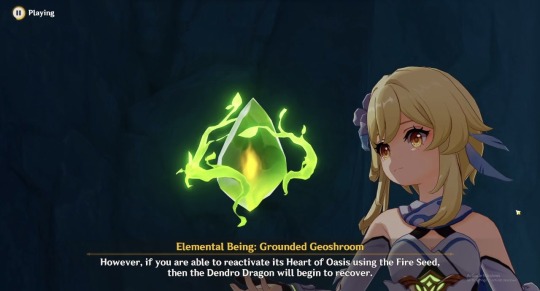
Video still from Star Dragon X
The Urstone also generally looks similar to the Fire Seed in terms of the stone’s shape and the orientation of the casing-like objects around it, but there’s a more compelling analogy to be drawn between their composition. The Fire Seed is described as an extremely high concentration of elemental energy in a very fragile or unstable state, and we know from our understanding of Irminsul that elemental energy is another form that memories can take. While it’s not clear if passing through the Urstone is the same thing as entering the Urstone itself, Avin does access more of her repressed memories of Arashani after doing so, allowing her to “remember,” as Arapurva asked her to. So, both seem to contain memories.
You may also know that the prefix Ur- in Urstone means primordial or original, something from before the present. This leads me to wonder if that light of the universe glowing from within the Urstone is what Roozevelt calls “primal energy.” Hoyoverse does like to worldbuild through analogies and allegories, so I wouldn’t be surprised if the visual similarities between the Fire Seed and Urstone were meant to be a tip for a functional similarity as well.
Finally, there’s the relationship between the Fire Seed and Apep’s Heart of Oasis. The Fire Seed was made by Greater Lord Rukkhadevata with the help of Apep’s “children,” the elemental beings that split off from that “source.” It is meant to mimic the Heart of Oasis and the way that it functions, which tells me that all of this will/”heart”/source as a seed imagery is being repeated for a reason, because it’s meant to teach us more about how “will” works.
Remember how the Aranara believe they can find the Sourcesong by learning every song, and how this points to the idea that the essence of the source is retained in each of its “children,” despite the unique form that each song takes? Well, let’s think about that for a second. For example, think about how light shining through a prism will split off into unique colors - each color is distinct from the other, with a unique character and “form,” so to speak, but each color still originates from light. Red, green, and blue may all look different from each other, but each tells you about a characteristic of this thing called light.
I think the same is true about these “seeds.” These fragments of an original consciousness can take the form of seeds because that is one facet of the essence of the source. That’s why an Urstone can be so many things at once: a “heart” (though not corporeal), an “ore,” a source, a will, and a seed. That is because each fragment of the source’s will conveys a small “idea” taken from the original consciousness, and these ideas are like fruits born from a tree. If you were to “plant” these seeds in the ground, the ideas would spread across the land, thereby allowing one’s will not just to dominate, but also to multiply.
*The “Seed of Ideas” heading title is taken from an enemy in Honkai Impact 3rd introduced in Chapter 33. Lore-wise, they’re actually not a great example of the idea I’m trying to illustrate here lol. So don’t think too hard about the heading if you’re a Honkai 3rd player – I just thought it sounded cool. >_>
Wherefore Did the Spirit Tree Grow?

“But the reason it is effective is due to the nature of the origin, the primordial... based on the records, the constituent elements should be a "Circle of Four Orthants" and a "Tree of Emanation"... flows from the roots toward the center of the circle, and the circle encircles the abstract of... It's akin to pie crust and the filling of the pie, a metaphor sure to excite Jakob.” -Book of Revealing, Enigmatic Page VIII
And plant them we shall! That is just what Greater Lord Rukkhadevata and Raiden Ei did with Egeria and Raiden Makoto’s consciousness. Egeria’s consciousness sleeping in the Gaokerena has always reminded me of Avin’s Urstone, long before having the language of “will” to talk about it, but I could never quite explain why. I think the answer is a little more clear to me now, though there’s no concrete way to prove this theory at the moment. The Harvisptokhm, the Sacred Sakura, and I would also venture to guess the tree at Windrise are the result of planting either the source of consciousness or a fragment of consciousness, which anchors the consciousness to the mortal realm and allows it to exert its will on the land by purifying and containing its “filth.”
These trees all belong to the consciousness of gods and ascended allogenes, but Avin is as ordinary as they come, so how is it possible to suggest that her Urstone is anything like the Gaokerena or Makoto’s will? Maybe all that’s missing is “time”?
So…what is "it"?
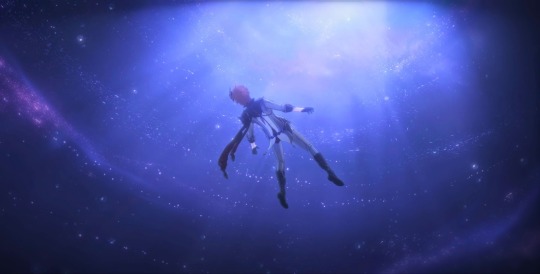
“An external form is but a gift of time. Through ‘growth’ comes change, and even abandonment of previous forms. However, our true nature is not so easily affected.” –”Where Lies the Path Home,” Sapientia Oromasdis: Act II
Now with all of that set-up out of the way, let’s get to the heart of the matter here…ignore the pun.
The Archon Quest establishes early on that Childe’s Vision’s malfunctioning and his bad mood are connected to one another, and with Act III and IV we see that Childe is literally being summoned by the whale – it is calling out to him, drawing him into a rift where it swims in the Primordial Sea. His Vision’s malfunctioning is what I want to zero in on first to begin to answer the larger question of what the whale is and explain Childe’s movements so far.
Once again, Aranyaka becomes very relevant here. When the Traveler saves Rana at the end of the quest after resealing Marana’s Avatar, Rana resolves to go out on an adventure and receives a Vision of her own. Though we are not shown a visual of this, it is described on a black screen of white text:
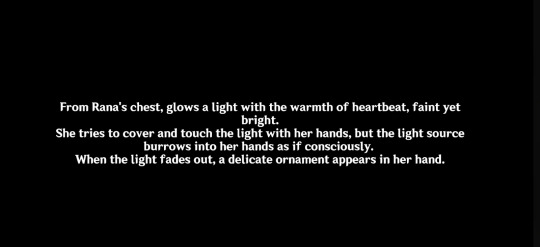
Rana pulling the Vision from “a light with the warmth of a heartbeat” from her chest is imagery we’ve already seen before, when Avin pulled the lens from her chest in the collective dream. I mean, isn’t the parallel a little too on the nose here? Avin created a lens, something you use to see and perceive, and Rana was granted her…Vision? …Why are you booing?
Although Rana’s is the only Vision story so far that fits this imagery like a glove, I think Act III and Act IV offer some more support for where I’m going with this. Despite having Childe’s Vision in their possession since Act I, the Vision is shown twirling at the beginning of every dream sequence the Traveler experiences in the Fortress of Meropide, sequences that seem to be copies of Childe’s memories while he was a prisoner. The fact that the Vision doesn’t need to be on the physical person of its wielder in order to transmit these memories could be an indication of a deeper connection between the Vision and the wielder – that is, the Vision is similarly a physical extension of its wielder’s “Will,” created by their Urstone or “Heart,” and therefore is a part of them, like the fruit of a tree. And if that’s true, then Venti wasn’t kidding when he compared Visions to organs.
This also puts the Vision’s malfunctioning into a different perspective. To go back to Nietzsche’s statement about Will to Power, will can only operate on will, and will is the causality of all things – through this lens, it may be correct to say that the traces of “it” that Skirk could sense on Childe are traces of the Abyssal whale’s will, and that its will is interfering with Childe’s own will at this fateful moment.
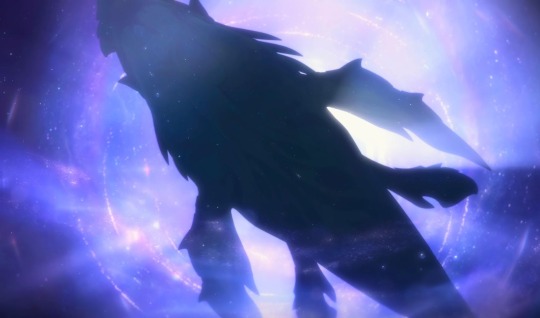
If we buy the idea that will is at least part of what can change your fate, and that Childe has traces of the whale’s will left on him, then the secret of why “it” has reappeared now may have been foreshadowed by what Nahida said in Yoimiya’s second story quest: that “meteor showers'' appear as a result of many intricate fates interfering with one another.
Specifically, it’s an allegory for Childe and the whale. The dream Childe had when he fell into the Abyss and the meteor shower are analogous, to be sure, but let’s not forget about our good friend Mr. Freud here either, who’s analysis shows us that dreams are suppressed wishes translated into images. From that perspective, it would also be correct to say that the meteor shower is analogous to a wish. That is, Childe’s fate and the whale’s fate are interfering with one another because of their encounter in the Abyss when he was a young teenager, and perhaps the Abyss appeared that day because Childe’s fate and the whale’s fate were interfering with each other then too - and that this was Childe’s wish all along:
“Pursued by bears and wolf packs, he lost his footing and fell into a bottomless crack in the earth's surface. There, he witnessed the endless possibilities of another ancient world. There, he would meet a mysterious swordswoman... Or perhaps one should say that this dark realm had sensed the burning ambition in this boy's heart.” –Tartaglia, Character Story 4
As for the larger question of what the whale is, it’s likely not very different from Visions, or the blades of the Raiden Gokaden, or Avin and the lens. It is an extension of the Abyss’s will that branched off from its source a long time ago, a primordial being much lower on the Abyssal phylogenetic tree than the more humanoid Abyss Heralds or mages. That’s as far as I feel comfortable speculating about its origins for now, but I hope we get some clarity on its age and “distance” from its source very soon. Speaking of which…we haven’t talked about Caribert yet, have we?

There’s something eerily similar about the way that Avin described her world as a “tiny space” before changing her fate when we consider the additional context of Caribert. When he regained consciousness, he said it felt like he had just woken up from a “long dream,” and that in his dream he was hiding in a “little room,” and that he had no desire to leave it. I think this language is similar on purpose, and it tells us some more crucial information about Urstones, will, and their relationship to these curses placed on the Khaenri’ahns.
The “little room” and the “tiny space” are metaphors for a person’s perspective, which has been repeated over and over again in nearly every Fontaine world quest thus far to further our understanding of aesthetics. It’s clear from those quests that an individual’s perspective is limited, but it can be broadened by interacting with others + the passage of time, and that over long periods of time these perspectives allow for aesthetic values to change. Thus, the world is also changed. But the opposite of change is stagnation, and stagnation is precisely the result of losing the ability to connect with others - indeed, the will to leave the tiny room.
We’ve already established that when “will” exerts its influence on another will, it can change the “shape” of the will it is dominating - the Frostbearing Tree is a great example of this. The Hilichurls have also had their external forms altered, and they erode away until eventually dissolving into the mud in the Chasm. So maybe, just maybe, the “curse of the wilderness” is a result of their will being tampered with by the same “thing,” such that their inner world becomes so small that they cannot find their will anymore, and therefore they cannot change their fate.
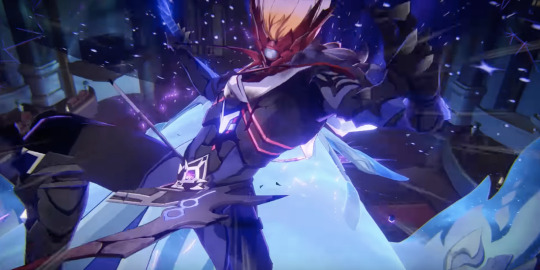
Childe is briefly seen fighting the whale in his Foul Legacy form in the version 4.2 trailer
Now, I’m not suggesting that the traces of the whale’s will would ever result in Childe becoming a Hilichurl, or that the whale is responsible for the curse of the wilderness at all. What I am wondering is if this is why Skirk took Childe up as her disciple – to teach him a “form” of combat that would maintain his grip on his will, on some kind of “belief,” not allowing it to be dominated by the whale’s will, so that there is yet hope that Childe can change his fate.
And if that is true, then here is my last theory before I disappear: Yoimiya’s belief that a child’s wish is precious and worth protecting is likely an allegory for Skirk’s motivation to train Ajax, and the relationship between Yoimiya and Avin is also meant to foreshadow them – a master and her disciple, a traveler from afar and a child of this world, a child-at-heart and a child who is lost. This core belief is what makes Yoimiya’s heart pure, and by passing that belief on to Avin, she plants the seeds of new hope for her to defy fate, and one day she may do the same for someone else. This, in essence, is the meaning of will, and that is what I believe Skirk’s lessons were meant to teach Ajax. And that is a twist that I truly never saw coming.
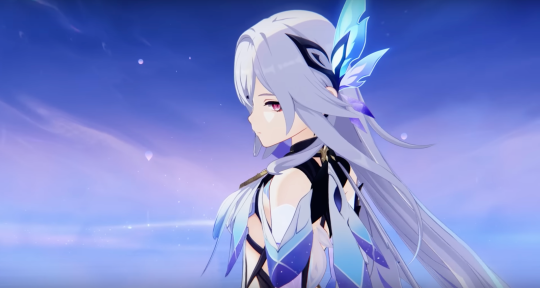
TL;DR: The Urstone is the source of will that exists in each person, will is what translates thoughts into images and objects, smaller "wills" or "ideas" split off from the Urstone/heart/source/consciousness and allow for will to spread and exert its influence on other wills, and Skirk may have more in common with Yoimiya than you thought.
Thank you so much for reading, I really hope it made some sense. I would love to hear what you think of all the lore up to this point and what you make of it! :)
Sources
Yoimiya Story Quest Act 2 (Full Quest) Carassius Auratus Chpater: Act II | Genshin Impact - YouTube- grabbed the “is this…the power of my heart?” screenshot from here because I forgot to take it in my alt’s playthrough.
Nahida Story Quest 2 - Using the fire seed to save Grounded Geoshroom | Genshin Impact 3.6 - YouTube - Video still of Lumine holding the fire seed from this video.
Beyond Good and Evil by Friedrich Nietzsche, which you can read for free here. Page numbers are given from my hard copy.
A General Introduction to Psychoanalysis by Sigmund Freud, also can be read for free here.
For more analysis of the Will to Power doctrine, check out Stanford Encyclopedia of Philosophy.
#genshin impact#genshin lore#genshin theory#genshin meta#genshin impact lore#genshin impact theory#fontaine#tartaglia#childe genshin#skirk#yoimiya#theory
77 notes
·
View notes
Text
Wanderer/Scaramouche/ Hat Guy Silly Headcannons
With some Nahida and Ei stuff included.
Definitely helps other Vahumana students with Inazuman history, and gets pissed when the textbooks are wrong about events he lived through, but he can’t say anything or else he’ll expose himself as non-human.
When Hat Guy in his Akedemia uniform he isn’t allowed to wear his hat, so his classmates just call him Guy. (This pisses him off as well)
He flies up the the sanctuary of saumsara instead of taking the stairs.
Nahida told him to write out all his feelings towards Ei and the other important people in his life as letters. Once he was done Nahida read them over and handed them back to him. Wanderer tells her that he burned them afterwards, but he actually keeps them in a drawer.
Sometimes he thinks about mailing Ei‘s to her, but probably never will.
Nahida has a blanket with Aranara on it as a part of the design. One time it ripped, making he very upset. When Nahida wasn’t looking Wanderer stole it and fixed it before returning it right back where it was as if nothing happened. (Nahida has no idea)
Akedemia students often call him “The Guardian of Wisdom” because of how protective he is over Nahida.
He doesn’t like that title because it feels to similar to his little sister’s. (The Guardian of Eternity)
Yes, he does consider the Raiden Shogun puppet as his little sister.
Wanderer flies into the highest branches of Sumeru city to relax. Mostly because the distance helps drown out the sound of the city and no one can reach him up there.
But also because, if you sit in a particular spot, you get an amazing view of Sumeru at sunset.
He doesn’t get physically tired (like at all), so he didn’t sleep often.
But he does get emotionally and socially tired.
After he expressed this to Nahida she suggested sleeping anyways, which did help.
Sometimes when sleeping Nahida comes into his room with her blanket and lies on top of the covers next to him.
Aranara often come in and out of the sanctuary of saumsara, and sometimes will let Nahida use them like a stuffed toy when she sleeps. Let’s just say Wanderer wasn’t the happiest when he discovered Nahida and multiple Aranara in his bed one morning.
He was mostly upset because he had to get up and ready, but he couldn’t get out of bed without waking them.
Scaramouche’s irminsul branch was only created after he gained consciousness.
Ei completely remembers making him, but doesn’t remember what happened to him. She checked her notes relating to his creation, and remembered a bit of it though.
Mostly though the fact that he reminded her of Makoto
Ei desperately wants to have him back, especially after her meetings with the Traveler, where she realized that a person like Makoto was who Inazuma needed to lead them, not a warrior like her and the shogun puppet. But she doesn’t even know how to begin to contact him.
Ei has heard of and read the paper that Hat Guy wrote about social issues in Inazuma (the one that convinced Nahida to enroll him into the Akedemia) but has no idea that her son was the one that wrote it.
Wanderer can still use electro. It is mentioned in his profile story that Dottore unlocked the power that Ei had suppressed.
So he can still use Electro, as it wasn’t re-suppressed, but prefers Anemo as it is much easier to use (because it comes from a vision).
He only uses electro in dire circumstances.
Now time for some hypothetical event headcannons :D
He’d be professional and polite when meeting with the shogun or Ei the first time.
But after that, him and Shogun would fight like siblings normally do unless Nahdia or Miko is there to babysit.
But like, Devine sibling fights. So only their behavior of them fighting is normal, not the fights themselves.
If him reuniting with Ei was in private and not public, he’d cry.
Like full on sobbing
And Ei had no idea why
Because she doesn’t remember abandoning him
And Nahida or Traveler would have to fill her in because he’d be too busy sobbing to speak
He would straight up ignore Miko’s existence if she ever tried to talk to him.
Koujo Sara would be jealous of how much attention he gets from the shogun (when it’s actually Ei)
Then she would see him fighting with the puppet and try to intervene (by helping shogun)
#genshin impact#genshin funny#genshin#small art account#small artist#raiden siblings#kabukimono#headcanon#genshin impact headcannons#stupid#silly goofy mood#i’m tired#this was written in class#scaramouche#the wanderer#raiden shogun#raiden ei#yae miko#nahida
60 notes
·
View notes
Text
HMMMMMMM
Imagine a genshin x reader series, but instead of the normal cheesy romance stuff, reader gets stuck in a repeating nightmare where they're stuck in different urban legend stories and have to solve the dream to wake up.
So for example, reader is stuck in the "kisaragi station" story in their dream, so they have to find clues and survive.
If the reader doesn't survive, they either die irl too or the dream repeats itself, growing more realistic and causing hallucinations the more it gets repeated.
Also, reader solves their dreams with different characters each time, depending on who they hung out with that day.
The characters in their dream also gets the dream, but they're unable to move by their own will, only being able to follow reader and talk random stuff
Almost as if they've become NPCs.
I'll probably write this on my alt account
@shitp0st-acc0unt
I've also got a few ideas for endings
+ this'll be an interactive fic, so your choice matters :D
#non-aranara related#genshin au#genshin brainrot#genshin x reader#genshin x you#genshin reader insert
58 notes
·
View notes